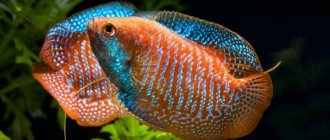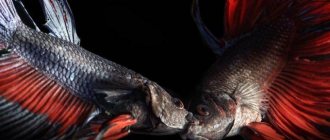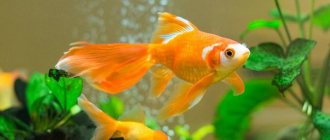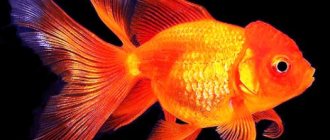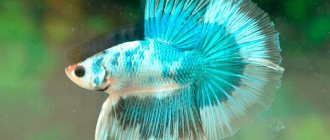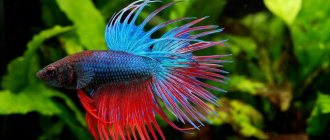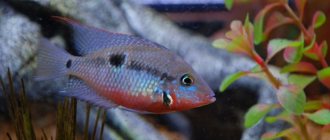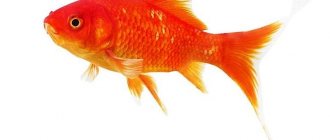Few aquarists know that Aulonocara multicolor, which belongs to the Cichlid family, is a fish that requires careful care. She has an attractive appearance and increased endurance. However, not only is the fish a predator, but it also requires the creation of special conditions of detention. And yet, knowing that she will grow up to be quite a large and beautiful individual, aquarists give preference to her.
Description
Aulonocara multicolor has the following external characteristics:
- variegated color (yellow-orange body covered with spots of blue-blue shades);
- the body is oval-shaped, flattened on the sides;
- the presence of a large pointed fin on the back;
- body length reaching 15 centimeters.
Inexperienced aquarists wonder how long individuals live. In properly created conditions, their life expectancy can reach 8 years.
Keeping in an aquarium
Aulonocara is used to staying in a spacious aquarium on the middle and lower level. If the aquarium is shared, then it is necessary to provide shelters and suitable decorations. Grottoes, stones, caves, clay pots must be present in the interior of the aquarium. The temperature ranges from 22-29°C, hardness 9-19, acidity 7-9.
Ferns, nymphea, anubias, cryptocoryne, hygrophila, limnophila, vallisneria are planted from plants, which over time become food for fish. Aeration and filtration with weekly replacement of a quarter of the water volume is important. The species is comfortable with different lighting conditions. But for the cold period you will need a heater that regulates the temperature.
The soil used is fine sand, covered no more than 2 mm. Fish are sensitive to the presence of ammonia; the soil must be clean and avoid silting. Aulonocara can live up to 8 years in aquarium conditions.
Return to content
Rose
Maintenance and care
Aquarium fish are quite demanding creatures. So that it does not get sick, develops properly, and reproduces, it is important to observe the basic conditions when arranging the aquarium. Water parameters should be as follows:
- temperature – 24-27°C;
- hardness – from 8 to 16 units;
- acidity (pH) – from 7 to 8 units.
It is important to remember that the water should always be clean and fresh. For this reason, aquarists recommend equipping a fish tank with a filter and even a compressor so that your pets have enough air. It is necessary to replace the water mass by at least a quarter weekly. The capacity of the tank for one fish should not be less than 80 liters, but if there are 5-6 of them - at least 200 liters.
Cichlids do not like bright lighting, so it is better to purchase lamps that provide diffused light. An excellent soil option is crushed pebbles, coarse sand, the layer of which should be at least 5 cm. Some people prefer crumbs made from corals. As for the placement of plants, they do not necessarily have to be present.
Typically, aulonocaras prefer space, a lot of free space. However, the presence of a small number of plants such as Anubias, Echinodorus, Nymphea will not hurt them. There should also not be a lot of decorative elements in the aquarium. It is advisable that enough substrate be left for the fish, unoccupied by plants and decorations. This way they can move freely around the aquarium.
About the most common options
The aquarium world is well acquainted with Aulonocara nyasa. Received the name “queen” for her chic appearance, she fully justifies it. In nature, it is found only in the African lake of the same name, preferring very clean water and freedom of movement.
aulonocara nyasa
Among aquarists, they often act as special favorites that people are proud of and show off. Such pets are able to communicate with their owner, greeting when he approaches. The fish also communicate with each other: their expressive body movements are often accompanied by special sounds.
Like many fish, aulonocara reaches a size of 15 cm in adulthood, has a large head and characteristic depressions in the gill area.
Interesting color variety by gender. According to descriptions, you can find blue, multicolor, yellow and even ruby males. A combination is possible in which the colors smoothly transition into each other.
Many people love the olive-greenish color. The fins have an expressive blue tint with black dots, except for the anal one, which is full of red splashes.
The most expressive blue coloring of the Nyas male is during the spawning period.
His favorite pastime is filtering the soil in order to find any living creatures. Therefore, the bottom area should be as large as possible. When calculating the amount of water required at the rate of 50 liters per individual, the aquarium should not be made high; it is better to lengthen and expand the configuration.
Compatibility and behavior
Aulonokara has a fairly peaceful disposition, and therefore its behavior towards other fish species is non-aggressive. However, there are certain types of individuals with which it is better not to populate them in the same tank. These include:
- pseudotropheus demasoni;
- Haplochromis cornflower;
- pseudotropheus lombardo;
- Melanochromis auratos;
- Cichlids of Lake Tanganyika.
In addition, you should not populate the described individual with related aggressor species. Aulonokara will only suffer from such a neighborhood. Good compatibility of individuals is observed with:
- catfish (ancistrus);
- labidochromis yellow;
- Copadichromis "Kadango";
- blue ackee;
- blue dolphin
When choosing neighbors for an aulonocare, it is important to take into account the peculiarities of preparing its diet at home, as well as the complexity of maintenance and care.
Features and habitat of Aulonocara
The most common color for males is bright blue. The fin has a clearly defined white edge on its back. There are ruby, yellow and albinos. On the sides of these fish, transverse stripes of dark tones are clearly visible. They are more noticeable among representatives of the fair sex. Their color is brown with olive tones.
Most often, this beauty can be found in nature on the territory of silted sediments or underwater rocks of Lake Malawi. They feel comfortable at great depths, in complete darkness. In such conditions it is very easy for them to hunt and hide from potential enemies. After all, the bottom of reservoirs is full of various predators and dangers. These are painfully peaceful creatures.
In a 150 ml aquarium, aulonocara can perfectly coexist with other species of fish, the main thing is that they are not aggressive. On the lateral line of these fish, which is their main organ, there are interesting neuromast cells, thanks to which they sense the slightest vibrations on the surface.
The fish also feel all changes, even the smallest ones, in water pressure thanks to the enlarged pores on the front part of their skull. The main food product of aulonocara in nature are insects and their larvae, which are mainly found on the sandy bottom.
That is why the fish stay close to him. Hunting for invertebrates is the favorite pastime of fish in nature. It's interesting to watch this. Aulonocara can hover motionless in the water for a long time near the habitat of its prey.
As soon as there is movement in the sand, the fish grabs the prey along with the sand and sifts it with the help of its gills. The fish immediately swallows the caught insect. The aquarium has a slightly different environment, a different world. Therefore, it is almost impossible to observe Aulonocara hunting. But you can observe the fish trying to find something in the sand.
Feeding
It is a known fact that the described individuals are unpretentious in food. Any food is suitable, both granulated and in the form of flakes. Individuals will not disdain “live” food, for example, cyclops, brine shrimp, and coretra. Bloodworms should be given to them in moderation. Aquarists recommend enriching and giving preference to foods containing a certain amount of carotenoids, as this will help improve the red shades on the fish.
Some cichlid breeders recommend making your own food. To make it at home, you will need the following ingredients:
- raw squid meat (mussels, shrimp);
- scalded lettuce leaves;
- scalded spinach, pumpkin or zucchini;
- calendula petals (sold at the pharmacy);
- saffron;
- paprika.
All ingredients are ground and mixed. It is recommended to give the resulting mass a maximum of twice a day to avoid overfeeding aquatic pets. Feeding aulonocara involves alternating several types of food.
Compatibility with other fish
Aulonocaras are peace-loving fish, only males are aggressive towards representatives of their species, and only during spawning. They get along well with Malawian cichlids - hummingbirds, blue dolphins, and other aulonocaras. When keeping several species of aulonocara, it should be taken into account that they can interbreed. Aggressive cichlids of the Mbuna group will become bad neighbors.
Aulonocara steveni
Reproduction and breeding
Breeding fish is possible both in a general aquarium and in a separate tank. It is important that the male is surrounded by several "girls" and that the scenery provides plenty of hiding places. This is necessary not so that the fish can “seclude themselves,” but so that the female can hide from the annoying advances of the male if she is not ready for them.
In addition, it is worth making sure that the male sees an open place in the substrate where he will prepare a hole for spawning. Flat stones are also suitable for these purposes. For fish reproduction to be successful, the temperature of the water masses must be at least 30°C. The female, who responded to the male’s advances, must lay eggs in the hole created by him. Then the future “dad” impregnates her.
The female takes the fertilized eggs into her mouth, where she keeps them for three weeks. In this way, aulonocara protect their offspring from being eaten by other fish.
Fry, caring for them
The hatched fry are moved to another tank. They are fed both dry and live food. The first few months of life, the young are distinguished by their inconspicuous color, which subsequently changes. The fry reach sexual maturity by one year.
What to feed
Aulonocara orchids are omnivorous. Animal food predominates in the diet. Plant food makes up 20–30%.
Live food
- Bloodworm is a mosquito larva. High-calorie, hemoglobin-rich, vitamin food.
- Koretra is a mosquito larva. Mobile dietary food. Forces fish to hunt.
- The tubifex is an annelid worm. Recommended for weakened and growing fish.
Do not purchase live food from unverified sellers. Fish caught in natural waters may be infected with infection, parasites, and contain harmful substances. The coretra is not so dangerous, since it lives and obtains food in the water column.
Frozen food
Fully preserves the usefulness of the living. It is not a carrier of parasitic and bacterial threats. But re-frozen is unsuitable for use. And this is impossible to control.
Dry food
They are not suitable for constant feeding: orchids lose color and stop reproducing. Helpful if you plan to be away for a long time. Use automatic feeders with a timer.
Goldfish coloring granules maintain color intensity. Ask 1-2 times a week.
Plant food
Purchased - tablets with spirulina. Dried and fresh herbs, nettle and dandelion leaves are suitable. Blanched zucchini, pumpkin, and cabbage are useful. From cereals - crushed oat flakes (“Hercules”).
Prepared feed
For high-quality color, aulonocara orchids require sufficient quantities of carotenoids (astaxanthin). It is found in significant quantities in red fish, carrots, and other red vegetables and fruits. Prepare and freeze minced meat containing the specified components with the addition of shrimp, squid, and mussels. Astaxanthin is also an antioxidant and improves metabolism and digestion.
Diseases, their prevention
The described representatives of the Cichlid family do not have a specific set of diseases inherent to them. In order for fish to avoid diseases, it is important to provide them with adequate living conditions. This is precisely what their prevention is all about.
Aulonocara multicolor is a beautiful, unusual aquarium fish, which is confirmed by its description. Inexperienced aquarists should not keep it, because it requires special care. However, if a person is confident in his own abilities, he can take risks. The main thing is to provide the fish with proper living conditions and food.
Reviews
Aquarists note the decorative qualities of Aulonocara orchid and its compatibility with peaceful fish. Easy to maintain.
Disadvantages include the bright exterior of only males and attacks on small fish and veiltails. They are prone to eating and digging up plants.
